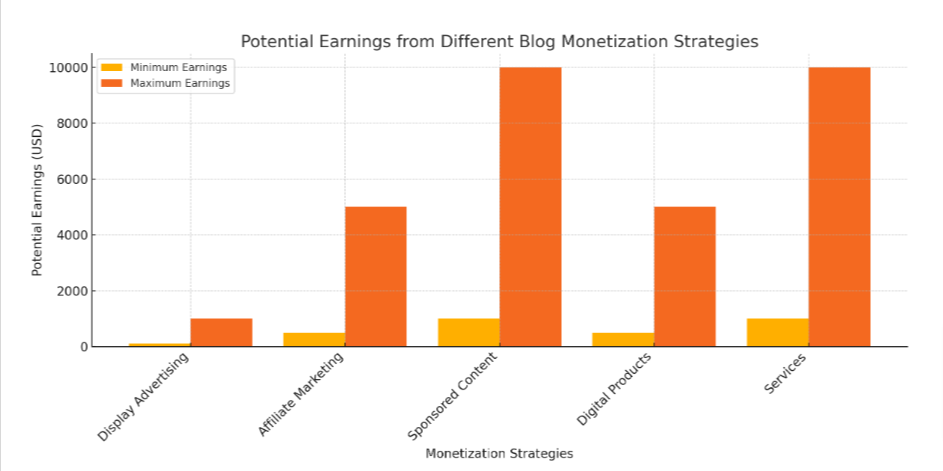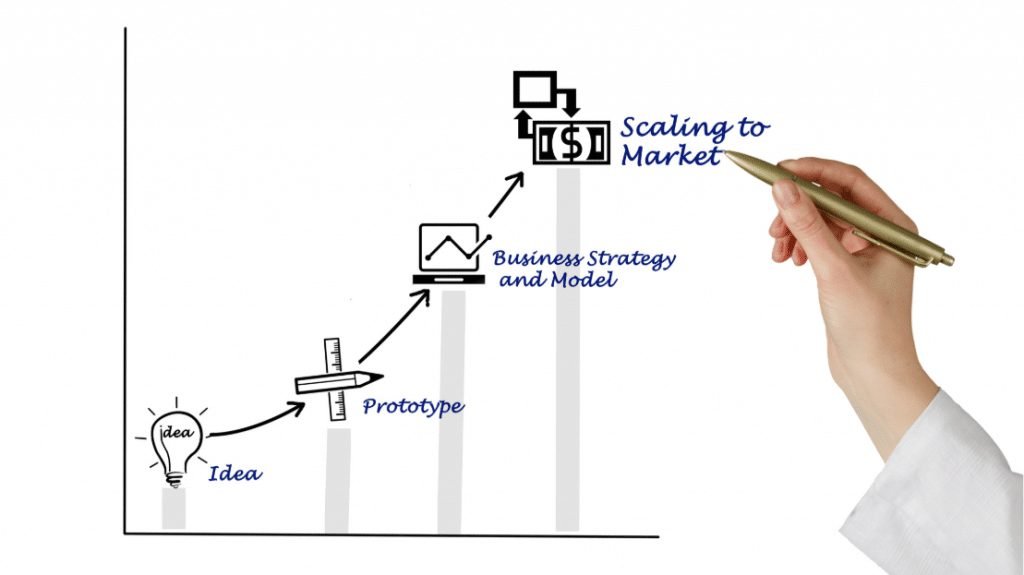Is a blog a business?
Unfortunately, no, a blog is not a business!
A blog is simply a place of business just like a studio, store, or office. While anyone can put up a professional-looking blog, turning it into a profitable venture requires more than just passion; it requires a strategic approach.
In this comprehensive guide, you’ll learn how to start a blog as a business and make money online. We’ll cover everything from niche selection and content strategy to monetization methods and scaling your business.
So, if you want to start a profitable blog business or are looking to boost your existing blog’s income, these steps will equip you with the tools and knowledge you need to succeed.
Let’s dive in and start building your blog as a business.
DISCLOSURE: WebIncomeJournal is supported by readers like yourself. We may earn an affiliate commission when you purchase through our links, which enables us to offer our content for free. Learn more here.
Understanding the Blogging Landscape

Let’s begin by understanding what the blogging landscape looks like in 2024.
Current State of Blogging in 2024
Blogging in 2024 is more dynamic than ever. With over 600 million blogs globally, the competition is fierce, but the opportunities are vast. The rise of social media platforms, SEO (Search Engine Optimization) tools, and digital marketing strategies has transformed how bloggers reach and engage their audiences.
According to recent statistics, blogs still remain one of the most effective ways to drive traffic, build brand awareness, and generate leads.
Types of Successful Blog Businesses
Successful blog businesses come in various forms, each with its unique approach and revenue model. Here are a few common types:
- Personal Blogs: These often start as passion projects and evolve into profitable ventures through affiliate marketing, sponsored content, and selling digital products.
- Niche Blogs: Focused on specific topics like fitness, travel, or technology. These blogs attract a dedicated audience and can monetize through display advertising and membership programs.
- Corporate Blogs: Businesses use these to establish authority, improve SEO rankings, and connect with customers. They often feature guest posting, tutorials, and company news.
Common Challenges Faced by Bloggers
Despite the potential for success, bloggers often encounter several challenges:
- Finding a Profitable Niche: Identifying a niche that is both interesting and lucrative can be daunting. It’s crucial to conduct thorough market research to validate your niche.
- Content Creation and Consistency: Maintaining a steady stream of high-quality content is essential but challenging. Bloggers must develop a robust content strategy and stick to a content calendar.
- SEO and Technical Skills: Optimizing content for search engines and managing the technical aspects of a blog can be overwhelming. Utilizing tools like Ahrefs, SEMrush, and Google Analytics can help.
- Monetization: Choosing the right monetization methods that align with your niche and audience requires careful consideration and experimentation.
“Blogging is not just about writing. It’s about finding your voice, building your brand, and engaging with your audience consistently.”
Understanding these elements of the blogging landscape is the first step in transforming your blog into a profitable business. The journey might be challenging, but with the right strategies and tools, success is within reach.
That being said, let’s now explore the 7-step blueprint for turning your blog into a business venture.
The 7-Step Business Blog Blueprint
Step 1: Define Your Niche and Target Audience

Defining your niche and target audience is the cornerstone of building a successful blog as a business. The right niche ensures that your content appeals to a specific audience, making generating leads and increasing website traffic easier. Selecting a profitable niche is crucial for several reasons:
- Focused Content: A clear niche helps you create content that resonates with your audience.
- Monetization Opportunities: Certain niches, like finance or health, have more lucrative monetization options.
- SEO Benefits: Specialized content can improve your SEO ranking by establishing your blog as an authority in that area.
How to Identify Your Ideal Reader
Understanding your ideal reader is key to tailoring your content and marketing efforts. Here are steps to identify them:
- Create Reader Personas: Develop detailed profiles of your target readers, including demographics, interests, and pain points.
- Engage with Your Audience: Use surveys, comments, and social media interactions to gather insights about your readers’ needs and preferences.
- Analyze Competitors: Study blogs in your chosen niche to see who their audience is and what content they engage with the most.
Conducting Market Research to Validate Your Niche
Validating your niche ensures that there is enough demand and potential for profitability. Here’s how you can conduct effective market research:
- Keyword Research: Use tools like Ahrefs and SEMrush to identify popular search terms in your niche. Look for keywords with high search volume and low competition.
- Analyze Trends: Check Google Trends to see if interest in your niche is growing, stable, or declining.
- Examine Competitors: Identify top blogs in your niche and analyze their content, audience engagement, and monetization strategies.
Practical Steps to Validate Your Niche
- Perform a SWOT Analysis: Evaluate the Strengths, Weaknesses, Opportunities, and Threats of your chosen niche.
- Survey Potential Readers: Use platforms like SurveyMonkey to gather feedback on your niche ideas.
- Pilot Content: Publish a few posts on your chosen niche and monitor the response using Google Analytics and Google Search Console.
Flowchart: Identify Your Niche
By defining your niche and understanding your target audience, you set a solid foundation for your blog as a business. This clarity will guide your content strategy, marketing efforts, and monetization plans, ensuring that your blog attracts and retains a dedicated audience.
Step 2: Develop a Content Strategy

Developing a robust content strategy is vital to turning your blog into a business. This strategy should align with your niche and audience, ensuring your content is both engaging and effective in driving traffic and generating revenue. Your content strategy must be tailored to your niche and audience. Here’s how to get started:
- Define Your Goals: Determine what you want to achieve with your blog—be it increasing website traffic, building brand awareness, or generating leads.
- Know Your Audience: Use the reader personas created in Step 1 to guide your content topics and style.
- Plan Your Content Types: Mix different content types to keep your audience engaged and cater to various preferences.
Understanding the Different Types of Blog Content
Different types of content serve various purposes and engage readers in distinct ways. Here are some popular types:
- Articles: Informative and in-depth pieces on specific topics.
- Reviews: Detailed evaluations of products or services, ideal for affiliate marketing.
- Tutorials: Step-by-step guides that provide value and establish authority.
- Listicles: Easy-to-read lists that summarize key points or tips.
- Interviews: Conversations with experts that add credibility and unique insights.
Optimizing Content for Organic Search Visibility (SEO Best Practices)
To ensure your content is discoverable, follow these SEO best practices:
- Keyword Research: Use tools like Ahrefs and SEMrush to find relevant keywords. Incorporate these naturally into your content.
- On-Page SEO: Optimize titles, meta descriptions, headers, and images. Ensure your content is structured with clear headings and subheadings.
- Internal and External Links: Link to other relevant content on your blog and high-authority external sites.
- Mobile Optimization: Ensure your blog is mobile-friendly, as a significant portion of traffic comes from mobile devices.
Crafting High-Quality Content That Resonates with Your Target Audience
High-quality content is essential for reader engagement and SEO. Here are tips for crafting compelling content:
- Be Authentic: Write in a voice that reflects your personality and brand.
- Provide Value: Ensure each post offers something valuable to the reader, whether it’s new information, a unique perspective, or actionable tips.
- Engage with Storytelling: Use storytelling techniques to make your content relatable and memorable.
- Edit Ruthlessly: Ensure your content is clear, concise, and free of errors.
Creating a Consistent Content Calendar to Maintain Reader Engagement
Consistency is key to maintaining reader engagement and building a loyal audience. Here’s how to create and stick to a content calendar:
- Plan Ahead: Use tools like Google Calendar or Trello to schedule posts in advance.
- Mix Content Types: Rotate between articles, reviews, tutorials, and other content types to keep your blog dynamic.
- Set Realistic Goals: Determine a posting frequency that you can consistently maintain, whether it’s weekly, bi-weekly, or monthly.
- Monitor and Adjust: Use Google Analytics and Google Search Console to track performance and adjust your strategy as needed.
By developing a well-rounded content strategy, you’ll not only attract readers but also keep them engaged and coming back for more. This strategy, combined with consistent effort and optimization, will set the foundation for a successful blog as a business.
Step 3: Build Your Brand and Online Presence

Building a strong brand and online presence is crucial for the success of your blog as a business. This step involves designing a professional blog layout, creating a cohesive brand identity, and effectively leveraging social media platforms to promote your content.
1. Designing a Professional Blog Layout: A professional blog layout enhances user experience and helps establish credibility. Here are key elements to consider:
- Responsive Design: Ensure your blog is mobile-friendly to cater to the growing number of mobile users.
- Clean Navigation: Make it easy for visitors to find content with a well-organized menu and search functionality.
- Readable Fonts: Use legible fonts and appropriate sizes for comfortable reading.
- Visual Appeal: Incorporate high-quality images, consistent color schemes, and white space to make your blog visually appealing.
2. Creating a Strong Brand Identity: A strong brand identity distinguishes your blog from others and builds trust with your audience. Here’s how to create one:
- Logo and Tagline: Design a memorable logo and create a catchy tagline that reflects your blog’s mission.
- Consistent Voice: Develop a unique writing style and tone that resonates with your target audience.
- Brand Colors: Choose a color palette that aligns with your brand’s personality and use it consistently across your blog and social media.
Related: How to Create an SEO-Friendly Website in 6 Proven Steps (A Comprehensive Guide)
3. Leveraging Social Media Platforms: Social media platforms are powerful tools for promoting your blog content and engaging with your audience. Here’s how to make the most of them:
- Choose the Right Platforms: Focus on platforms where your target audience spends the most time, such as Facebook, Twitter, Instagram, or LinkedIn.
- Share Regularly: Post regularly to keep your audience engaged and attract new followers.
- Engage with Followers: Respond to comments, join relevant conversations, and build a community around your blog.
4. Content Promotion Strategies: Effective content promotion is key to driving traffic and growing your blog as a business. Here are some strategies:
- Guest Blogging: Write guest posts for established blogs in your niche to reach a broader audience and build backlinks.
- Email Marketing: Build an email list and send regular newsletters to keep your subscribers informed and engaged.
- SEO Optimization: Optimize your blog posts with relevant keywords, meta descriptions, and internal links to improve your search engine rankings.
By focusing on designing a professional blog layout, creating a strong brand identity, and leveraging social media platforms effectively, you can build a robust online presence that attracts and retains readers. Implementing these content promotion strategies will further amplify your reach and drive traffic to your blog, setting the stage for a successful business venture.
Step 4: Monetization Strategies

Turning your blog into a revenue machine requires selecting the right monetization strategies that align with your niche, audience, and content. The following are some ways that bloggers earn money. You may choose the methods that best suit your blog.
- Display Advertising: Display advertising is a straightforward way to monetize your blog. Popular options are Google AdSense and Mediavine which helps you earn money each time a visitor clicks on an ad.
- Affiliate Marketing: Affiliate marketing involves promoting products or services and earning a commission on sales generated through your referral links. Examples are Amazon Associates and Affiliate Networks like ShareASale and CJ Affiliate.
- Sponsored Content and Brand Partnerships: Partnering with brands for sponsored content allows you to earn money by writing posts that promote a brand’s products or services.
- Digital Products: Creating and selling digital products is an excellent way to leverage your expertise and provide value to your audience. Examples of digital products include e-books, online courses, and printables.
- Coaching and Consulting Services: If you have expertise in a particular area, offering coaching or consulting services can be a highly profitable monetization strategy. You can provide personalized advice and support to clients, offer professional advice to businesses or individuals in your niche, or host workshops or group sessions to reach more clients at once.
Here’s a list of the different monetization methods with their pros, cons, potential earnings, and effort required:
| Monetization Method | Pros | Cons | Potential Earnings | Effort Required |
| Display Advertising | – Easy to implement – Passive income – Scales with traffic | – Low revenue per visitor – Can clutter the site – Dependent on traffic volume | Low to Medium | Low |
| Affiliate Marketing | – Potentially high earning – Passive income – Can be niche-specific | – Requires trust and relevance – Commission-based – Can be competitive | Medium to High | Medium |
| Sponsored Content | – High earning potential – Builds brand partnerships – Can be niche-specific | – Requires negotiation – Can affect authenticity – Time-consuming | High | High |
| Digital Products (e-books, courses) | – High profit margins – Scalability – Full control over pricing | – Requires creation and maintenance – Initial investment of time and resources – Marketing needed | Medium to High | High |
| Services (Coaching, consulting) | – High earning potential – Builds authority – Personal interaction | – Time-consuming – Limited scalability – Requires expertise | High | High |
And, here’s a bar graph comparing the potential earnings from different monetization strategies:

Step 5: Optimize for Search Engines and User Experience

To transform your blog into a successful business, optimizing for both search engines and user experience is crucial. Here’s how you can achieve that balance.
1. On-Page SEO Techniques: On-page SEO is essential for improving your blog’s visibility in search engine results. Key techniques include:
- Keyword Research: Use tools like Ahrefs or SEMrush to find relevant keywords for your niche.
- Title Tags and Meta Descriptions: Write compelling and keyword-rich titles and meta descriptions.
- Header Tags (H1, H2, H3): Structure your content with appropriate header tags for better readability and SEO.
- Internal Linking: Link to other relevant posts within your blog to improve navigation and SEO.
2. Technical SEO Basics: Technical SEO focuses on the backend of your blog to ensure search engines can crawl and index your site efficiently.
- Site Speed: Use tools like Google PageSpeed Insights to improve loading times.
- XML Sitemap: Create and submit an XML sitemap to Google Search Console.
- Robots.txt: Optimize your robots.txt file to guide search engines on which pages to crawl.
- Structured Data: Implement schema markup to help search engines understand your content better.
3. User Experience (UX) Best Practices: A positive user experience keeps visitors on your blog longer and encourages repeat visits.
- Responsive Design: Ensure your blog looks great on all devices.
- Easy Navigation: Create a clear and intuitive menu structure.
- Readable Content: Use short paragraphs, bullet points, and images to make your content easy to read.
4. Mobile Optimization: With a significant amount of web traffic coming from mobile devices, optimizing your blog for mobile is non-negotiable.
- Responsive Themes: Choose themes that automatically adjust to different screen sizes.
- Mobile-Friendly Testing: Use Google’s Mobile-Friendly Test tool to ensure your site is optimized for mobile users.
- Fast Load Times: Optimize images and reduce redirects to improve mobile loading times.
By focusing on these aspects, you can ensure your blog is both search engine-friendly and user-centric, paving the way for greater visibility and audience engagement.
Step 6: Analyze and Adapt

Continuous analysis and adaptation are key to maintaining and growing a successful blog business. Website analytics tools like Google Analytics and Google Search Console provide invaluable insights into how your blog is performing. By regularly reviewing these analytics, you can understand what’s working and what needs improvement.
Understanding Key Metrics
Focusing on the right metrics is essential for informed decision-making. Key metrics to track include:
- Traffic: The number of visitors to your blog.
- Engagement: Metrics such as bounce rate, average session duration, and pages per session.
- Conversion Rates: The percentage of visitors who take a desired action, such as signing up for a newsletter or making a purchase.
Using Analytics Data to Understand Your Audience
Analytics data helps you understand which content resonates with your audience and what doesn’t. Look at metrics such as:
- Top-performing posts: Identify which blog posts are driving the most traffic and engagement.
- Audience demographics: Understand the age, location, and interests of your readers.
- Behavior flow: See how users navigate through your blog to identify any drop-off points.
A/B Testing Different Strategies
A/B testing involves comparing two versions of a webpage or piece of content to see which performs better. This can be used to optimize various elements of your blog, such as:
- Headlines: Test different headlines to see which one attracts more clicks.
- Calls to Action (CTAs): Experiment with different CTA wording, placement, and design.
- Layout: Compare different page layouts to determine which one leads to higher engagement and conversions.
By leveraging website analytics and continuously testing and optimizing your strategies, you can ensure your blog remains dynamic, engaging, and profitable.
Step 7: Scale Your Blog Business

Scaling your blog business involves strategic planning and leveraging various resources to grow sustainably. Here’s how to expand your blog’s reach and profitability.
1. Outsourcing and Delegation: As your blog grows, managing all aspects on your own can become overwhelming. Outsourcing and delegating tasks can help you focus on high-impact activities. Some of the tasks you may want to outsource include:
- Content creation
- Social media management
- Technical maintenance
- Graphic design
The benefits of outsourcing include:
- Increased efficiency: Focus on core activities while experts handle specific tasks.
- Quality improvement: Leverage specialized skills to enhance your blog’s quality.
- Time management: Free up time to concentrate on growth strategies.
2. Diversifying Income Streams: Relying on a single income source can be risky. Diversifying your revenue streams ensures financial stability and growth. Here are some income diversification strategies:
- Display advertising: Use platforms like Google AdSense and Mediavine.
- Affiliate marketing: Promote products and earn commissions via Amazon Associates or other affiliate networks.
- Sponsored content: Partner with brands for sponsored posts.
- Digital products: Sell e-books, online courses, or printables.
- Coaching and consulting: Offer personalized services based on your expertise.
3. Networking and Collaborations: Building relationships within your niche can open up opportunities for collaboration and growth. Networking helps you connect with other bloggers, influencers, and industry leaders. Here are some tips for networking success:
- Attend industry conferences and events.
- Participate in online forums and social media groups.
- Collaborate on guest posts and joint ventures.
4. Investing in Personal Branding: Your personal brand is a powerful asset that can differentiate your blog and attract a loyal audience. Invest in building a strong personal brand to enhance your blog’s appeal. Here are some strategies you should deploy:
- Consistency: Maintain a consistent voice and style across all platforms.
- Authenticity: Share your personal story and experiences to connect with readers.
- Professionalism: Ensure your blog design and content reflect high standards.
By outsourcing tasks, diversifying income streams, networking, and building a strong personal brand, you can effectively scale your blog business and achieve long-term success.
Common Pitfalls to Avoid
Even the most well-planned blog businesses can encounter challenges. Here are some common pitfalls to avoid:
1. Inconsistent Posting: Consistency is key to building a loyal audience and improving your blog’s SEO. Regular posting keeps your audience engaged and signals to search engines that your site is active. Here are some tips for success:
- Create a content calendar: Plan your posts in advance.
- Batch content creation: Produce multiple posts at once.
- Set realistic goals: Commit to a posting schedule you can maintain.
2. Neglecting Audience Engagement: Ignoring your audience can lead to decreased traffic and loyalty. Engaging with your readers builds a community around your blog. Here are some tips to help:
- Respond to comments: Show appreciation and address questions.
- Use social media: Interact with followers and share user-generated content.
- Email newsletters: Keep your audience updated with regular emails.
3. Overlooking Legal and Tax Considerations: Legal and tax issues can be complex but are crucial for a sustainable blog business. Ensuring compliance protects your blog and its revenue. Here are some legal and tax tips:
- Register your business: Consider forming an LLC or corporation.
- Understand taxes: Keep track of income and expenses for tax purposes.
- Consult professionals: Seek advice from legal and tax experts.
4. Chasing Trends Instead of Building Authority: Following every new trend can dilute your blog’s focus and authority. Instead, aim to establish yourself as an expert in your niche. To build authority:
- Focus on quality: Produce well-researched, high-quality content.
- Stay true to your niche: Consistently cover topics relevant to your audience.
- Build relationships: Collaborate with other authorities in your field.
By avoiding these common pitfalls, you can maintain a steady path to turning your blog into a successful business.
Success Stories and Case Studies
Learning from those who have successfully turned their blogs into profitable businesses can provide valuable insights and inspiration. Here are a few notable examples:
1. Pat Flynn – Smart Passive Income: After being laid off, Pat Flynn started Smart Passive Income. He now earns over $100,000 per month from his blog through various income streams like affiliate marketing, courses, and sponsorships. Here are a few key takeaways from Pat’s business strategy:
- Diversify income streams: Don’t rely on just one source of revenue.
- Transparency: Sharing income reports builds trust with your audience.
- Educational content: Providing value through tutorials and guides can attract and retain readers.
2. Michelle Schroeder-Gardner – Making Sense of Cents: Michelle Schroeder-Gardner began her blog to document her journey to pay off student loans. Her blog, Making Sense of Cents, generates over $100,000 per month, primarily through affiliate marketing. Here are few things we can learn from her business model:
- Focus on a relatable story: Sharing personal experiences can resonate with readers.
- Strong affiliate strategy: Promoting products that align with your niche can be highly profitable.
- Consistent content creation: Regular posts keep the audience engaged and coming back for more.
3. Harsh Agrawal – ShoutMeLoud: Harsh Agrawal created ShoutMeLoud to share his blogging and digital marketing knowledge. He now makes a significant income from multiple revenue streams, including affiliate marketing, ads, and online courses. The key takeaways from his strategy include:
- Leverage SEO: Optimizing for search engines can drive organic traffic.
- Build a community: Engage with your readers through comments and social media.
- Expand your offerings: Consider adding courses or eBooks to diversify income.
By studying these success stories, you can gather actionable insights and strategies to implement on your blog. These examples demonstrate that, with the right approach, it’s possible to turn your blog into a profitable business.
Conclusion
Building a successful blog as a business is a journey that involves careful planning, dedication, and continuous learning. In this comprehensive guide, we explored 7 proven steps to building a blog as a business.
It’s important to note here that the path to turning your blog into a profitable business requires persistence and dedication. Each step is an opportunity to learn and grow. You don’t have to be discouraged by challenges rather use them as motivation to refine your strategy and improve your content.
So what are you waiting for? Now is the perfect time to take the first step toward transforming your blog into a revenue-generating platform. Start by defining your niche, creating a content plan, and setting up your blog. With the right approach and a commitment to excellence, you can achieve your blogging goals and enjoy the rewards of your hard work.
Are you ready to embark on your blog business journey? Start today and turn your passion into a thriving business!
Frequently Asked Questions
Can a blog be considered a business?
Yes, a blog can definitely be considered a business. When you treat your blog as a business, you focus on creating valuable content, building an audience, and implementing monetization strategies to generate revenue. Many successful bloggers run their blogs as full-fledged businesses, complete with marketing plans, financial management, and growth strategies.
Is a blog a good business?
Absolutely, a blog can be a very good business. It offers low startup costs, flexibility, and the potential for high returns. By providing valuable content, engaging with your audience, and implementing effective monetization methods, you can turn your blog into a profitable venture. Successful bloggers often enjoy the freedom to work from anywhere and the satisfaction of building a community around their passion.
Can blogs still make money?
Yes, blogs can still make money in 2024 and beyond. The key is to stay updated with the latest trends, produce high-quality content, and utilize various monetization strategies such as affiliate marketing, sponsored content, display advertising, and selling digital products. By continuously adapting and improving your blog, you can create a sustainable income stream.
What type of blog is most profitable?
Starting a blog can be relatively inexpensive. Some common costs associated with starting a blog are domain name: $10 – $15 per year, web hosting: $3 – $10 per month (e.g., Bluehost, Hostinger), blogging platform: Free (e.g., WordPress.org) or up to $25 per month for premium features (e.g., WordPress.com, Squarespace), themes and plugins: Free to $100+ (depending on the level of customization), marketing and promotion: Variable (can start with free methods, but may invest in paid advertising). On average, you can start a blog with as little as $50 to $100 initially. If you need a customized cost estimate for your blog, try our Blog Cost Calculator.
How much money can you make from a blog?
The income from blogging can vary widely based on factors such as niche, audience size, content quality, and monetization strategies. Some bloggers make a few hundred dollars per month, while others earn thousands or even six-figure incomes annually. For example, new bloggers: $0 – $500 per month, intermediate bloggers: $500 – $5,000 per month, and established bloggers: $5,000+ per month. Success depends on your dedication, consistency, and ability to adapt and grow your blog.
Can I make money blogging in 3 months?
While it’s possible to start earning some money from your blog within 3 months, significant income usually requires more time and consistent effort. In the first few months, focus on building high-quality content, growing your audience, and optimizing your blog for search engines. As your blog gains traction, you can start implementing monetization strategies like affiliate marketing and sponsored content. With persistence and a strategic approach, you can begin to see financial returns in a relatively short period.






Great post! I found your 7-step guide to building a blogging business incredibly insightful and actionable. Turning a blog into a successful business is something many aspire to, but having a clear road map makes all the difference.